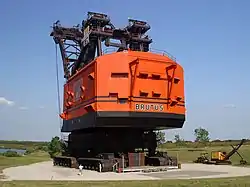Big Brutus
Big Brutus is the nickname of the Bucyrus-Erie model 1850-B electric shovel, which was the second largest of its type in operation in the 1960s and 1970s. Big Brutus is the centerpiece of a mining museum in West Mineral, Kansas where it was used in coal strip mining operations. The shovel was designed to dig from 20 to 69 feet (6.1 to 21.0 m)[1] down to unearth relatively shallow coal seams, which would themselves be mined with smaller equipment.
| Bucyrus Erie Model 1850-B "Brutus" | |
|---|---|
 Note people by track for scale | |
| Type | Electric shovel |
| Manufacturer | Bucyrus-Erie |
| Production | 1 unit made; June 1962 to May 1963 at a cost of $6.5 million |
| Length | 79.5 feet (24.2 m) (house) |
| Width | 58 feet (18 m) (house) |
| Height | 160 feet (48.8 m) (to tip of boom) |
| Weight | 9,300,000 pounds (4,200,000 kg) + 1,700,000 pounds (770,000 kg) ballast when operational |
| Propulsion | Caterpillar tracks |
| Gross power | ≥7,500 hp (standard), ≥15,000 hp (peak) |
| Speed | 0.22 mph (19 ft/min) (5.8m/min) max |
| Blade capacity | 90 cubic yards (68.8 m3) or 150 short tons (140 t) |
Description
Fabrication of Big Brutus was completed in May 1963, after which it was shipped in 150 railroad cars to be assembled in Kansas. It operated until 1974, when it became uneconomical to mine coal at the site. At that time it was considered too big to move and was left in place.
Big Brutus, while not the largest electric shovel ever built, is the largest electric shovel still in existence. The Captain, at 28 million pounds (13 kt) – triple that of Big Brutus – was the largest shovel and one of the largest land-based mobile machines ever built, only exceeded by some dragline and bucket-wheel excavators. It was scrapped in 1992, after receiving extreme damage from an hours-long internal fire.[2]
Museum
The Pittsburg & Midway Coal Mining Company donated Big Brutus in 1984 as the core of a mining museum which opened in 1985. In 1987, the American Society of Mechanical Engineers designated Big Brutus a Regional Historic Mechanical Engineering Landmark.[3] It was listed on the National Register of Historic Places in 2018.
The museum offers tours and camping.
Restrictions
Prior to 2010, visitors were allowed to climb the maze of ladders to the top of the 160-foot boom. After Mark Mosley, a 49-year-old dentist from Lowell, Arkansas, died attempting to base-jump from the top of the boom, the attraction's board of directors decided to prohibit climbing and access to the boom is now blocked by locked doors.[4]
See also
References
- "Archived copy" (PDF). Archived from the original (PDF) on 2010-07-03. Retrieved 2010-03-26.CS1 maint: archived copy as title (link)
- Haddock, Keith (September 18, 2000). Colossal Earthmovers. MBI. pp. 67. ISBN 978-0-7603-0771-7.
- "About Big Brutus". Big Brutus, Inc. Retrieved 2009-07-19.
- Younker, Emily (18 January 2010). "Co-worker: Base jumper no novice". Joplin Globe. Retrieved 22 November 2020.